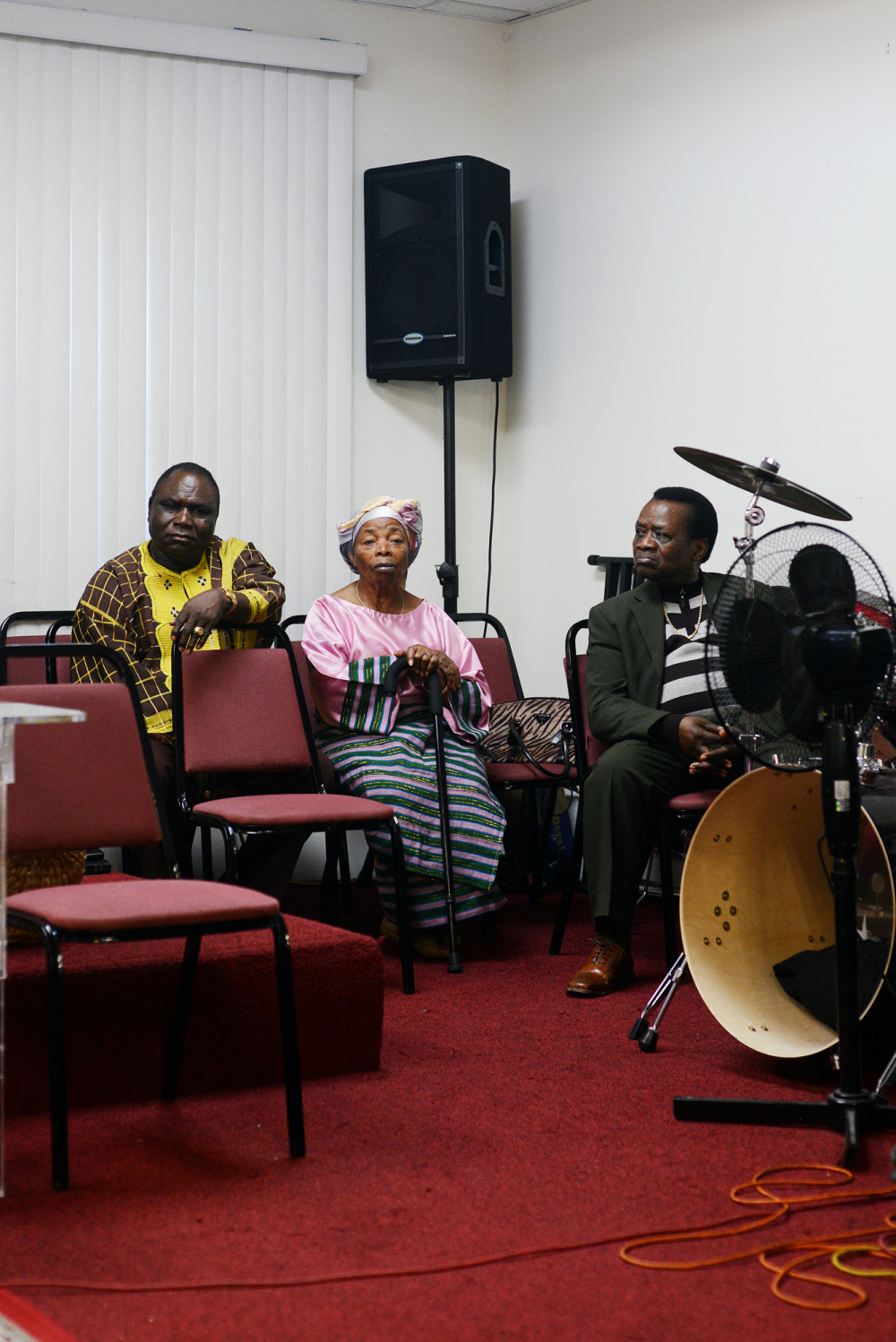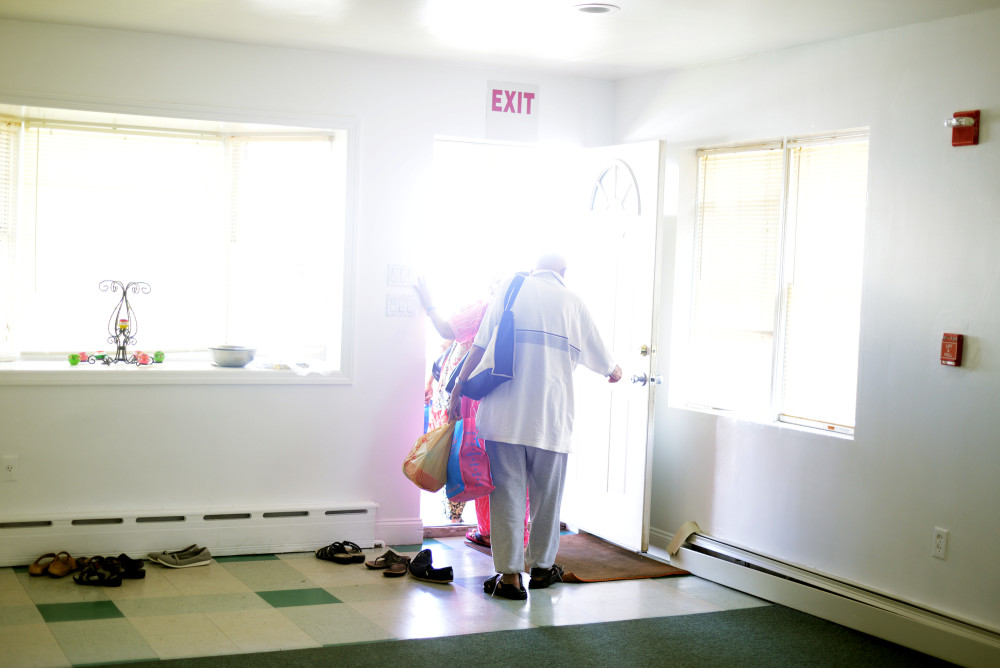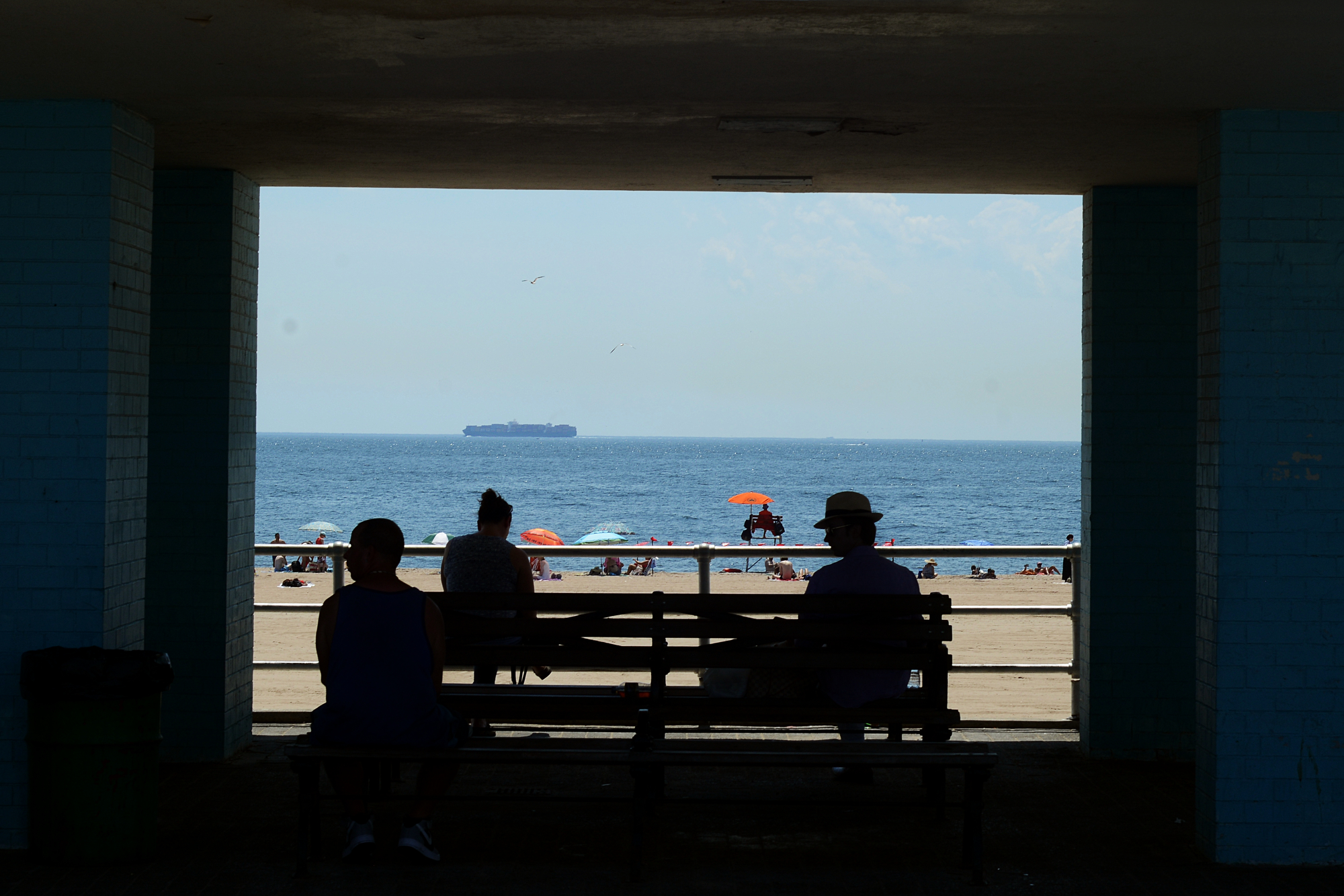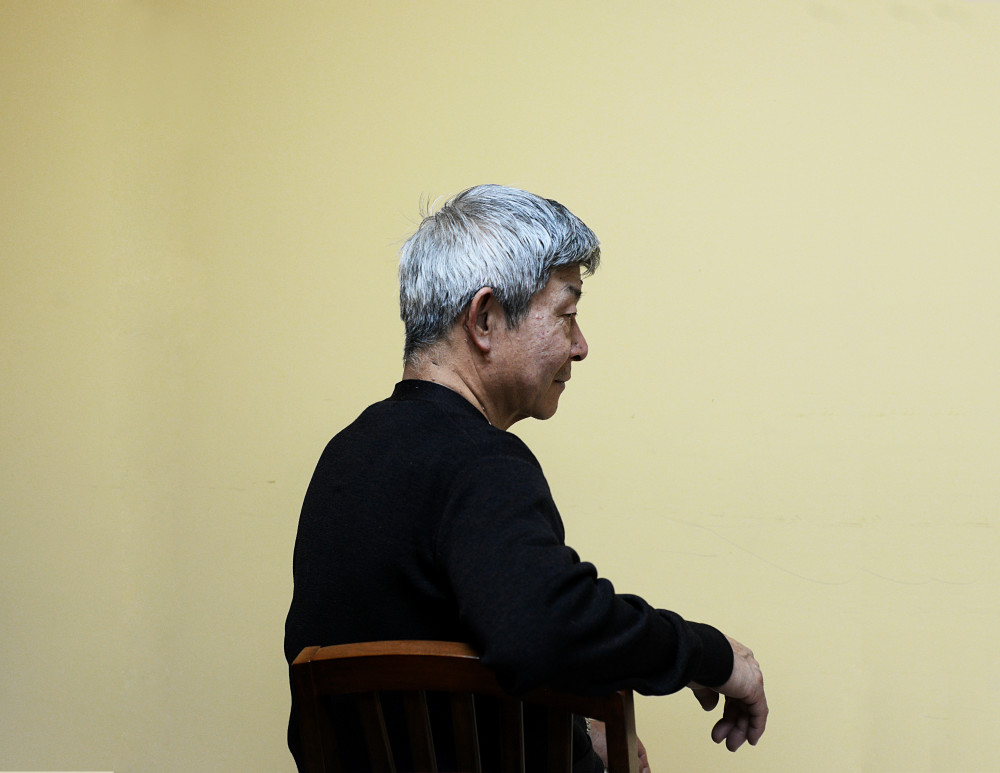Part 2: I Can Only Pray
Tucked away in Staten Island’s Clifton neighborhood is a fourth-floor apartment painted in drowsy greens and browns. A blend of savory aromas—fish gravies, okra, fufu, stewed bitterballs—fills the air as brightly dressed women chat over bowls of chicken stew with rice.
Monah Smith, a small, wizened woman with a quiet smile, has been cooking for them. Smith sells home-cooked meals from her apartment in Park Hill, a low-income housing complex. The place never seems to be empty. Staten Island is home to the largest Liberian community outside of Africa, and many of Smith’s fellow immigrants drop by—at almost any hour of day—for the traditional, slow-cooked dishes she makes.
Smith came to the United States just before Liberia’s first civil war broke out in 1989. Shortly afterward, her husband, who had hoped to join her and their daughter in New York, was killed in the pivotal battle that led to the capture and murder of Samuel Doe, then Liberia’s president. Smith stayed in America, hoping to return to her country soon, but the fighting persisted, with a short interlude, for over a decade. In 2001, her son died in Liberia, and Smith decided to stay put.
When Smith couldn’t find regular work in the city, she decided to cook from her apartment. In addition to the extra income, it gave her the chance to spend more time with people from her country. That connection is important to her. “My grandmother had a house in New Jersey and practically abandoned it because she was homesick for Little Liberia,” says her granddaughter, Monah Manneh.
Nationally, one in ten older immigrants lives in New York. The city’s fastest-growing demographic, they account for half of New Yorkers who are sixty years or older. With its diversity, efficient public transportation, and generous social services, the city would seem to be an ideal place to grow old. Nevertheless, many older immigrants feel isolated here. For some, that isolation worsens feelings of helplessness and depression. And even when resources exist to assist people their age, language and cultural barriers often stand in their way.
Charles Stevens, another Liberian immigrant who lives on Staten Island, points out that his country has over twenty dialects. Many of those who immigrate come from rural parts of Liberia and have no formal education. For the older émigrés, it is particularly hard to get the assistance and skills they need, he says, to “find their place as elders with respect.” As resilient as they are—many survived war, after all—they are also scared of losing their community and culture. This was the fear that drove Stevens’s own mother to wait out the civil war at home rather than join her son in America. “It is something to lose all your material possessions,” says Stevens, seventy-five. “But is it more to lose your culture?”
Without adequate help, life in America can overwhelm older immigrants. Lyubov Volkhorev, a Russian Jewish immigrant, left her life in St. Petersburg behind at the age of sixty-two. She came to the United States, she says, to take care of her ailing mother and escape a wave of anti-Semitism that had struck her city.
It took Volkhorev a year to find work, and she struggled to find proper care for her mother. “I was so scared of a system that I could not understand because my English was so, so, so bad,” she says. “Not only did I have to have conversations in English with the doctors, but the medicines, too—my god, even in Russian I couldn’t pronounce them! It was very hard.”
She retired at sixty-five without a pension or health insurance. Because she had not lived in the country for five years, she did not qualify immediately for Medicare, the government-funded health insurance system for seniors.
In her case, however, her industriousness eventually pulled her out of her despair. Unlike many other immigrants, she refused to cloister herself within her neighborhood of Coney Island, with its sizeable Russian community. She learned the ways of life in her new home, taking advantage of resources like the English classes at the senior center across the street. “I have to use this language,” she says. “If I stay in the Russian community, I forget everything English.”
Now seventy-five and insured, Volkhorev is feeling more content these days. She lives half a block from the beach, in a Section 202 housing complex for the low-income elderly. Mementos from Russia are framed throughout her apartment, which is painted in a palette of blues, her favorite color. Her hobby of writing and translating poetry from Russian to English, she says, keeps her busy.
Nevertheless, she remembers how hard life was in those early years in New York. “If I look back, I would die,” she says. “I look forward. Only I know what it cost me.”
With all the challenges older immigrants face—adjusting to a foreign culture, accessing health care, dealing with social isolation—it is not surprising that they often face issues with their mental health. What makes their situation even worse is the stigma that their cultures often attach to mental illness, leaving them to suffer in silence.
In Sunset Park, a Brooklyn neighborhood where Chinese immigrants make up over half the population, there has been a spate of suicides this year—at least three by immigrants. “In the Chinese community, mental health is largely unrecognized as a legitimate health issue,” says Dr. James Chou, a psychiatrist and president of the New York Coalition for Asian American Mental Health. “They don’t know what depression is. They only know the physical qualities. So often they go to the doctor with symptoms related to depression or mental illness, and the doctor says, ‘You’re fine.’ But they aren’t, and the issue, the underlying depression, isn’t addressed.”
Sunset Park resident Hong, sixty-five, has been dealing with mental illness for decades. (His name has been changed to protect his identity.) Back in China, Hong worked for the government in Guangzhou province. At a certain point he began noticing he was experiencing bursts of energy followed by deep depressions. The highs were incredible for his work life; he could memorize anything and basked in praise from his colleagues. But when the lows set in, the despair paralyzed him, taking away his ability to communicate with his family and preoccupying him with suicidal thoughts.
His sister, who had studied medicine in the United States and recognized his symptoms as depression, urged him to seek treatment. A doctor gave him mood stabilizers but failed to diagnose him as bipolar. In the early nineties, Hong and his family decide to immigrate to America. Concerned about his mood swings, he asked his doctor if the move would be a good thing. His doctor assured him he wasn’t sick anymore, and gave him mood stabilizers to take “as needed” abroad.
 When Hong and his family arrived in New York, his poor English limited him to jobs in clothing factories, supermarkets, and restaurants. He worked long hours for low wages and no benefits. But Hong remained optimistic, reminding himself that the money was better, and his life more free, than in communist China.
When Hong and his family arrived in New York, his poor English limited him to jobs in clothing factories, supermarkets, and restaurants. He worked long hours for low wages and no benefits. But Hong remained optimistic, reminding himself that the money was better, and his life more free, than in communist China.
In 1998, Hong had a work-related accident that left his right hand seriously injured. Unable to find work, he grew depressed again. He was out of medication, without health insurance, and incapacitated by his injury.
The situation persisted for years, until Hong came across an ad in a Chinese newspaper for a psychiatrist in Brooklyn. Finally, Hong decided to get treatment. It helped that he knew the doctor would understand his culture and language, he says.
Today, Hong is on a long-term treatment plan and considers himself a role model for people in his community. “Forgive my pride,” he says through an interpreter. “But I am so grateful. I want people like me to know there is help out there, even at sixty-five.”
Asian Americans are less likely than other groups to mention their mental health concerns to friends, family, or doctors, according to a report by the Suicide Prevention Resource Center. Yet, the problem is prevalent in the community, especially for older immigrants: the majority of Asian American New Yorkers who kill themselves are men over eighty-five and women over seventy-five.
“They came here twenty years ago and work so hard, and they get lonely,” says Dr. Xu Chen, the founder of the Chinese American Sunshine House, a nonprofit focused on mental health in the Brooklyn Chinese community. At the same time, the elderly may feel themselves to be a burden and don’t want their children to struggle financially to care for them. The pressure leads many immigrants, especially recent ones, to consider suicide, Chen says. “In Chinese culture we believe in reincarnation, so some feel, ‘Why not finish it and come back in another form?’”
The stigma against people with mental illness is also strong, mental health professionals say. They are regarded as violent, unintelligent, or weak. “In China, psychiatrists are only seen for schizophrenia,” Chen says. When they come to America, Chinese immigrants often bring that preconception with them. “They don’t understand the Western way of thinking—that mental health is an umbrella term—because in China it’s not that way.” Even if they know they can get help, they often feel too ashamed to seek it out. Things have improved, Chen says, but when she started treating people in the community, many of them resisted any advice to see her. (“Why? I’m not crazy!” they’d say.)
Meanwhile, national organizations that address mental health issues don’t provide sufficient support, she says. She cannot send her patients to their websites or hotlines because they don’t offer information or services in Chinese. (The website for Asian American Suicide Prevention and Education does list two multilingual hotlines.) Advocacy organizations and policymakers could also do more, she says, to support local groups that respond to the direct needs of their communities. “It doesn’t take a big budget to fix these things.”
At the Park Hill housing complex, a half-dozen older Liberian women often sit outside—sometimes with their home health aides—selling nuts, fried plantains, and candies to passersby. In a parking lot around the corner, women hawk vegetables handpicked from a New Jersey farm, along with African foods like smoked fish and palm oil.
A previous incarnation of this open-air market was shut down for operating without a permit, but a local community group later helped the women get approval to sell in the lot. Once the weather turns cold, however, they will no longer be able to work. Jennifer Brumskine, the president of the Staten Island Liberian Cultural Association, says her group is now looking for an indoor space so that the market can be year-round.
The market, she points out, is more than a source of income for the women. It is also a way to keep them from becoming too isolated—a growing concern in Park Hill, where many immigrants age in place while the younger generations move out.
 These sorts of neighborhood venues give older immigrants the chance to connect with one another and feel at home. Houses of worship can also play this role. For instance, the Ganesh Temple of Queens, the largest Hindu temple in North America, offers a senior program to help members adjust to growing old outside of India. Nirmala Ramasubramanian, who helped form the group, says the idea was to create a supportive space for friends her age. “We knew some were going to local senior centers and would just sit there,” Ramasubramanian says. “They couldn’t relate to bingo. At lunch they wouldn’t touch the stuff—many Hindus are vegetarians.”
These sorts of neighborhood venues give older immigrants the chance to connect with one another and feel at home. Houses of worship can also play this role. For instance, the Ganesh Temple of Queens, the largest Hindu temple in North America, offers a senior program to help members adjust to growing old outside of India. Nirmala Ramasubramanian, who helped form the group, says the idea was to create a supportive space for friends her age. “We knew some were going to local senior centers and would just sit there,” Ramasubramanian says. “They couldn’t relate to bingo. At lunch they wouldn’t touch the stuff—many Hindus are vegetarians.”
In Hinduism, life has four stages, or ashramas. Ramasubramanian and her husband, M.K., both in their seventies, are in the third stage, Vanaprastha, when a person prepares for the end of life and the moment of merging with God and breaking all worldly ties. “We are embracing it,” she says. She tries to bring a similar philosophy of interconnectedness to her work with members of the senior program. Together, they take part in cultural activities like yoga, cooking, and singing bhajans—Hindu devotional songs. Ramasubramanian, a dietitian, also spends time educating them about health issues. “We check up on them,” she says. “Bring them food, drive them places. We embrace them.”
Ramasubramanian says the group’s members worry often about the future—with their children’s Western ways, will they end up in a nursing home? (A relatively new idea in India, a culture that values taking care of one’s elderly parents at home, nursing homes are still perceived as a form of neglect.) Many also suffer from a sense of displacement. As partners die, and children leave home to live, work, or study in other cities, even some of those who have been in the community for decades become detached, Ramasubramanian says.
She knows this feeling very well. Her husband came to America soon after the federal government passed the Immigration and Nationality Act of 1965, which liberalized immigration rules and removed strict quotas on the flows of people from non-European countries. When Ramasubramanian followed a few years later, she brought very little with her—“$24, one suitcase, a shoulder bag, and two kids”—because she was sure they would return to India within eighteen months. One valuable thing she did bring was a small silver statue of Ganesh, a Hindu deity known as the remover of obstacles—who would also turn out to be the patron of the temple she later joined.
Many years and a house later, Ramasubramanian says that she and her husband have given up on the idea of going back to India. Their children have grown up with more Western identities—a battle their parents declined to fight. For her part, she is thankful that in New York she was able to obtain an education and pursue a career as a dietitian, a life she could not have had in India.
Nevertheless, at times she will still ask herself, “Oh, why did I leave home?” Cutting “that umbilical cord,” she says, is very hard. “Even now.”
As for Monah Smith, the Liberian immigrant who cooks from her home, she has never come to see herself as American. “She’s so old-school African, she’s never worn pants,” Manneh, her granddaughter, says with a laugh. Now in her eighties, she is Liberian “through and through,” Manneh says—and she still wears her wedding ring.
But as Smith has grown older, her world has shrunk. She cannot move around like she used to. She leaves her home only to go church or get something from the closest store. “Loneliness,” her granddaughter says, “is a problem.”
Part 2: I Can Only Pray
Reporting for this article was supported by a Community Health Reporting Fellowship from the International Center for Journalists.
Dana Ullman Dana Ullman is a freelance photographer based in Brooklyn. Her photography is focused on social engagement: chronicling everyday epics, investigating subjects crossculturally, and humanizing faceless statistics through storytelling. Site: ullmanphoto.com
- Follow us on Twitter: @inthefray
- Comment on stories or like us on Facebook
- Subscribe to our free email newsletter
- Send us your writing, photography, or artwork
- Republish our Creative Commons-licensed content


